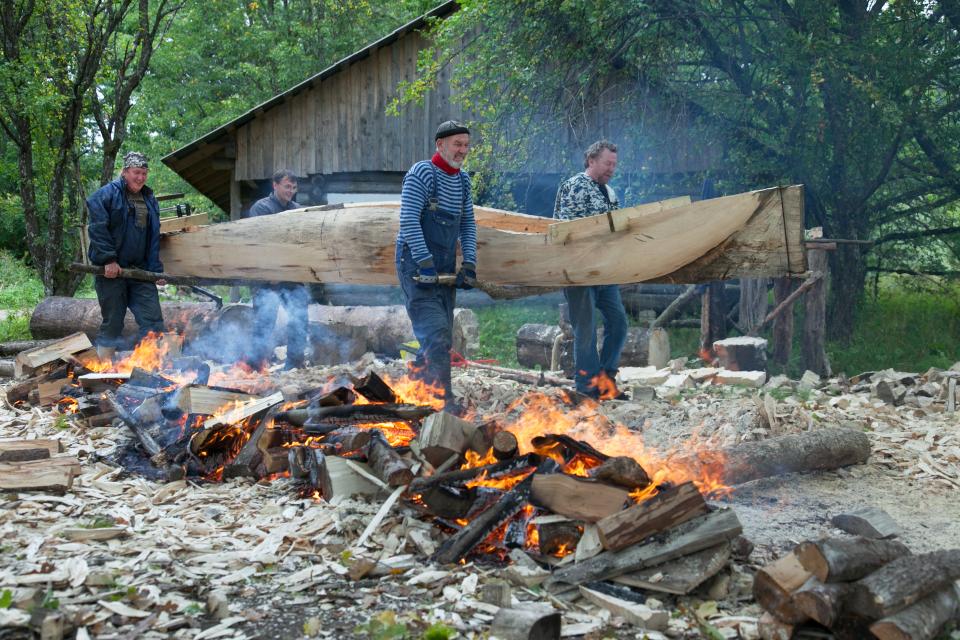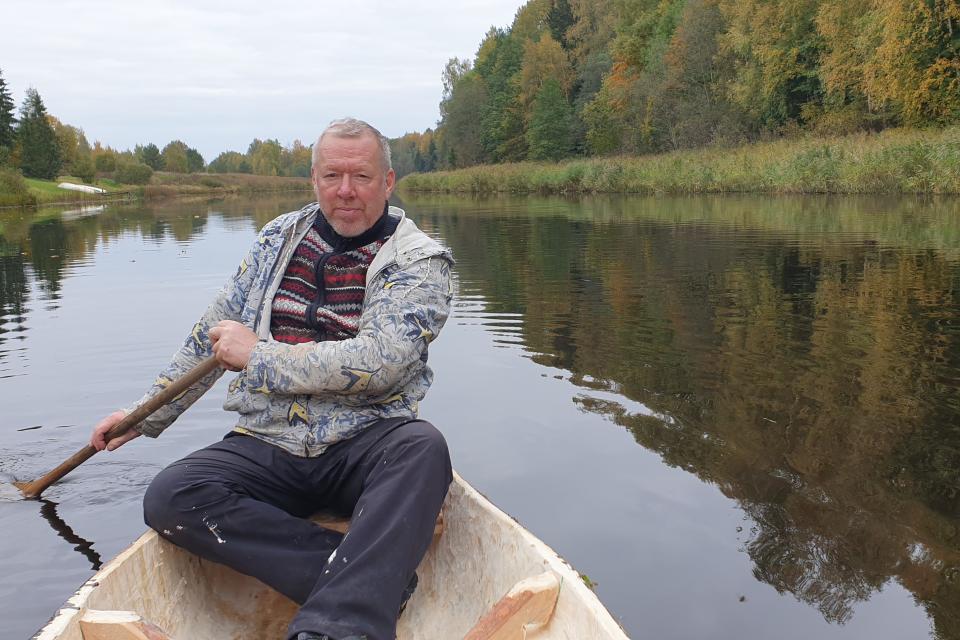There are still a few inhabited houses in Soomaa today that flood every spring; the owners can literally enter their houses in boats. Of course, this is an exotic experience nowadays, unlike 40 years ago when Aivar Ruukel (55), the initiator of the UNESCO-bid, moved to Soomaa.
Ruukel moved to Soomaa with his family as a fifth-grader and enjoyed an adventurous childhood of canoeing, hunting and exploring wildlife. He learned to build the logboats from the last old masters in the 1990s. By then, locals had stopped using the logboats for daily life and the craft of boatbuilding was disappearing. Ruukel says that he very narrowly caught the last moment to pick up the traditional skill:
“Both Jaan Rahumaa and Jüri Lükk, the last boat masters, died within a few years. I and a few friends have carried on the tradition of wearing a shirt and a suit jacket when working on the boat in their memory.”
Ruukel thinks the “haabjas” dates back to the bronze age and has Finno-Ugric roots: “Many Finno-Ugric peoples have built similar logboats with a similar technique. I’ve seen them built by the Vepsa and Mari people.”
All you need is an axe
Ruukel has built 15 logboats now, almost one for every year: “For a typical Soomaa logboat, you need an aspen stem of 50 cm diameter and 5-6 meters of length. The first step is to peel the log to see which way to position it.
The outer shape is most important and this needs to be carefully measured and positioned. Then, I cut off a few cm from the bottom, after that the longest part of the work can begin – to empty the inside of the wood so that the shell will be just 2 cm thick. This is being done by the ancient method with an axe.”
Ruukel says the method is not set in stone: “As the tools and skills have developed over centuries, it would be strange to stick to the building method of one certain era. The old men I learned it from already used small motor saws, so it’s ok to adjust to the new tools and to use them.”
Expanding the sides of the haabjas however is a ritual of its own that sticks to the tradition. The hollow stem will be filled with water and placed on a bonfire. When the water starts heating the wood inside the boat, the inner fibres expand while the outside fibres shrink because of the dry heat of the bonfire. This leads to a natural expansion.
Then the sides will be pulled apart and bent with sticks until the boat is about one metre wide. To support the shape, bows will be attached inside – selected from naturally bent tree branches and fir roots. To finish off, the logboat has to be treated with tar.
The logboat of Soomaa is almost always made from aspen, thus even the name “haabjas” haab stands for aspen in Estonian. Aspen is flexible enough not to crack under pressure. It has also adapted to grow in wet areas. Apart from being suitable for logboats, aspen are also a favourite home for the rare, flying squirrels in Estonia. The oldest trees and even dead aspen stems boast a wealth of biodiversity: more than 2000 species inhabit it.

From the local obscurity to UNESCO world heritage
The historical records of the daily use of logboats are, of course, rare. For the last century and a half, their usefulness and necessity are well-documented. For Soomaa households, the logboat was the basic means of transport during most of the year, except for winter.
It was used not just during the flooding season but also in summer and autumn to transport people and goods along the rivers, such as pots of milks or stacks of hay. Two or more logboats were tied next to each other for larger loads. Steering with one oar, standing in the boat like a gondolier in Venice, the elegant ride is a skilful balancing act. A seated rowing position is recommended for greater stability.
The idea to apply for the UNESCO title came about from international cooperation of logboat enthusiasts. Ruukel started the application process in 2018 with the aim of promoting and preserving the heritage, but also to promote the region and enhance its identity through a unique local symbol.
The listing is also helpful in attracting more people to try building logboats themselves. Ruukel and other Soomaa enthusiasts organise camps and workshops to attract the next generation. Building a logboat can be a great school project for the surrounding region that teaches practical skills as well as traditions and history.
There is also special value in creating something tangible with one’s own hands. As in the old times, a boat master is a respected person in the community.
Today, preserving the tradition and promoting the skill is the main role of the Soomaa logboat builders. The stories, legends and rituals that surround the haabjas are more valuable than their practical use in daily life.
While in history, haabjas was the only means to get around for daily chores during the flooding season, today it is an attraction for tourists. Plastic canoes have replaced haabjas as the most popular water vehicle for exploring the rivers and forests of Soomaa. Ruukel’s phone keeps ringing with people asking his prediction for the arrival of the floods. Nature is still unpredictable and the visitors have to wait for the news patiently.



